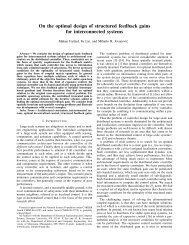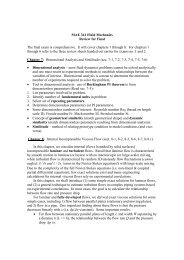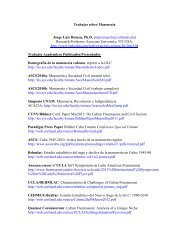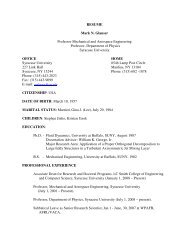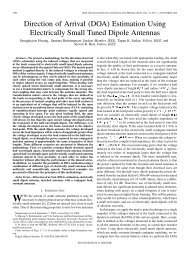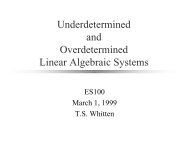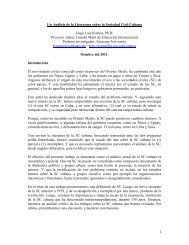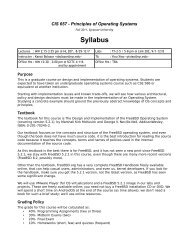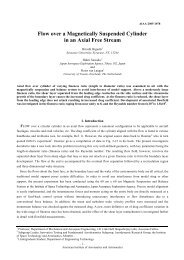Utilization of a Unitary Transform for Efficient Computation in the ...
Utilization of a Unitary Transform for Efficient Computation in the ...
Utilization of a Unitary Transform for Efficient Computation in the ...
You also want an ePaper? Increase the reach of your titles
YUMPU automatically turns print PDFs into web optimized ePapers that Google loves.
176 IEEE TRANSACTIONS ON ANTENNAS AND PROPAGATION, VOL. 54, NO. 1, JANUARY 2006<br />
II. THE UNITARY TRANSFORM<br />
A square matrix, , is called unitary, if it satisfies<br />
. The superscript denotes <strong>the</strong> complex conjugate<br />
transpose <strong>of</strong> a matrix. Hence , where is <strong>the</strong> identity<br />
matrix. For <strong>the</strong> matrix to be unitary, <strong>the</strong> columns <strong>of</strong> <strong>the</strong> matrix<br />
must be orthonormal. This implies .<br />
A matrix A, where<br />
, is called centro-hermitian<br />
[9]–[11], if it satisfies<br />
is called <strong>the</strong> exchange matrix and def<strong>in</strong>ed as<br />
.<br />
. . . . .<br />
.<br />
.<br />
.<br />
.<br />
.<br />
(1)<br />
. Here, is a square<br />
matrix, and is conjugate <strong>of</strong> .<br />
Theorem 1: If a vector<br />
, where is an odd number, is centro-hermitian, that is<br />
, <strong>the</strong>n <strong>the</strong> follow<strong>in</strong>g matrix :<br />
.<br />
.<br />
.<br />
.<br />
. (6)<br />
.<br />
There<strong>for</strong>e, . is centro-hermitian.<br />
Theorem 3: If <strong>the</strong> matrix is centro-hermitian, <strong>the</strong>n<br />
is a real matrix. Here <strong>the</strong> matrix is unitary, whose<br />
columns are conjugate symmetric and has a sparse structure<br />
[8], [14]. For even, we have<br />
Here, and are matrices that have <strong>the</strong> dimension <strong>of</strong> and<br />
. When is odd, we have<br />
(7)<br />
(8)<br />
.<br />
.<br />
.<br />
.<br />
. ..<br />
.<br />
.<br />
is also centro hermitian.<br />
Pro<strong>of</strong>: S<strong>in</strong>ce<br />
, <strong>the</strong>n<br />
<strong>for</strong><br />
. There<strong>for</strong>e<br />
(2)<br />
Here and are matrices that have <strong>the</strong> dimension <strong>of</strong> ,<br />
and 0 is a vector whose elements are 0.<br />
Pro<strong>of</strong>: Us<strong>in</strong>g , <strong>the</strong> conjugate <strong>of</strong> is<br />
S<strong>in</strong>ce<br />
(9)<br />
(10)<br />
(11)<br />
.<br />
.<br />
.<br />
.<br />
. ..<br />
.<br />
.<br />
(3)<br />
There<strong>for</strong>e,<br />
is a real matrix.<br />
.<br />
.<br />
. .. . .<br />
(4)<br />
Hence,<br />
is a also centro-hermitian matrix.<br />
Theorem 2: The follow<strong>in</strong>g matrix<br />
.<br />
is centro hermitian <strong>for</strong> any matrix [9].<br />
Pro<strong>of</strong>: Us<strong>in</strong>g<br />
.<br />
. , and<br />
.<br />
. ,wehave<br />
III. THE MP METHOD<br />
The narrowband sources located <strong>in</strong> <strong>the</strong> far field <strong>of</strong> a uni<strong>for</strong>mly<br />
spaced array consist<strong>in</strong>g <strong>of</strong> isotropic omnidirectional po<strong>in</strong>t sensors<br />
radiat<strong>in</strong>g <strong>in</strong> free space is considered. This results <strong>in</strong> a uni<strong>for</strong>m<br />
l<strong>in</strong>ear array (ULA). The focus here is to use <strong>the</strong> unitary<br />
trans<strong>for</strong>m to convert <strong>the</strong> complex matrices used <strong>in</strong> <strong>the</strong> MP <strong>for</strong>mulation<br />
to real matrices and use <strong>the</strong>se matrices to estimate <strong>the</strong><br />
DOA <strong>of</strong> multiple signals simultaneously imp<strong>in</strong>g<strong>in</strong>g on <strong>the</strong> ULA.<br />
The vector is <strong>the</strong> set <strong>of</strong> voltages measured at <strong>the</strong> feed po<strong>in</strong>t<br />
<strong>of</strong> <strong>the</strong> antenna elements <strong>of</strong> <strong>the</strong> ULA. There<strong>for</strong>e, can be<br />
modeled by a sum <strong>of</strong> complex exponentials, i.e.<br />
(12)<br />
.<br />
.<br />
. (5)<br />
where<br />
observed voltages at a specific <strong>in</strong>stance ;<br />
noise associated with <strong>the</strong> observation;<br />
actual noise free signal;<br />
;




